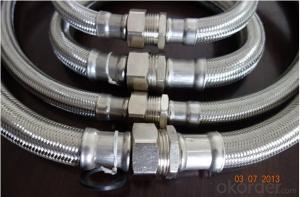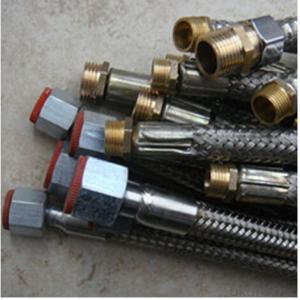Stainless Steel Braid Hose with Outside Fittings
- Loading Port:
- Tianjin
- Payment Terms:
- TT OR LC
- Min Order Qty:
- 1000 pc
- Supply Capability:
- 100000 pc/month
OKorder Service Pledge
OKorder Financial Service
You Might Also Like
Item specifice
Stainless Steel Braid Hose with Outside Fittings
Applications of Stainless Steel Braid Hose with Outside Fittings:
--Refueling system
--Chemical and pharmaceutical industry
--Industrial hydraulic systems
--Air conditioners in industrial and construction –site vehicles
--Food and beverage industry
--Special and standard industrial applications
--Water and cleaning management
Features of Stainless Steel Braid Hose with Outside Fittings:
1. )O. D.: 13-18MM 0.2-3M long
2. )Nut.: Nickel/Chrome Plated Brass (Zinc / Iron / Aluminum is available)
3. )Size Of Nut.: Female&Male 1/2''; 3/4''; 3/8''; 7/8''; 5/16'', and M10...
4. )Insert.: Brass (Zinc / Aluminum / Plastic is available)
5. )Inner tube.: Rubber/ EPDM/PVC
6. )Covered Material: Stainless Steel 201, 301, 304 /Aluminium Wire
7. )Working Pressure: 5Kg-15Kg
8. )Temperature: 0-92° C
9. )Quality Assurance: 3 years
RemarkAPPLICATION: HOUSEEHOLD WARE, BATHROOM WARE, SHOWER HOSE
PAYMENT: T/T, L/C
DELIVERY TIME: 20DAYS OR 30DAYS AFTER RECEIVED 30% DEPOSITS
MOQ: 5000PCS
ODM&OEM IS ACCEPTABLE
PackageInner: PP bag /Blister packing Outer: Carton box
Specifications of Stainless Steel Braid Hose with Outside Fittings:
NO | I.D | Refer to O.D | Working pressure | Burst pressure | approximate Weight | |||||
(inch) | (mm) | (inch) | (mm) | MPa | Psi | MPa | Psi | kg/m | lbs/ft | |
1 | 1/8 | 3.2±0.2 | 0.35 | 9±0.3 | 2.06 | 300 | 8.27 | 1200 | 0.078 | 0.12 |
2 | 5/32 | 4±0.2 | 0.4 | 10±0.3 | 2.06 | 300 | 8.27 | 1200 | 0.092 | 0.14 |
3 | 3/16 | 4.8±0.2 | 0.43 | 11±0.3 | 2.06 | 300 | 8.27 | 1200 | 0.108 | 0.16 |
4 | 1/4 | 6.3±0.3 | 0.5 | 12.7±0.3 | 2.06 | 300 | 8.27 | 1200 | 0.134 | 0.2 |
5 | 5/16 | 8.0±0.3 | 0.56 | 14±0.3 | 2.06 | 300 | 8.27 | 1200 | 0.147 | 0.22 |
6 | 3/8 | 9.5±0.3 | 0.63 | 16±0.4 | 2.06 | 300 | 8.27 | 1200 | 0.182 | 0.27 |
7 | 15/32 | 12±0.3 | 0.75 | 19±0.5 | 2.06 | 300 | 8.27 | 1200 | 0.238 | 0.35 |
8 | 1/2 | 12.7±0.4 | 0.78 | 20±0.5 | 2.06 | 300 | 8.27 | 1200 | 0.262 | 0.39 |
9 | 5/8 | 16±0.4 | 0.94 | 24±0.5 | 1.03 | 150 | 4.12 | 600 | 0.351 | 0.52 |
10 | 3/4 | 19±0.4 | 1.13 | 28.8±0.5 | 1.03 | 150 | 4.12 | 600 | 0.515 | 0.77 |
11 | 1 | 25.4±0.5 | 1.38 | 35±0.6 | 1.03 | 150 | 4.12 | 600 | 0.637 | 0.95 |
Images of Stainless Steel Braid Hose with Outside Fittings:
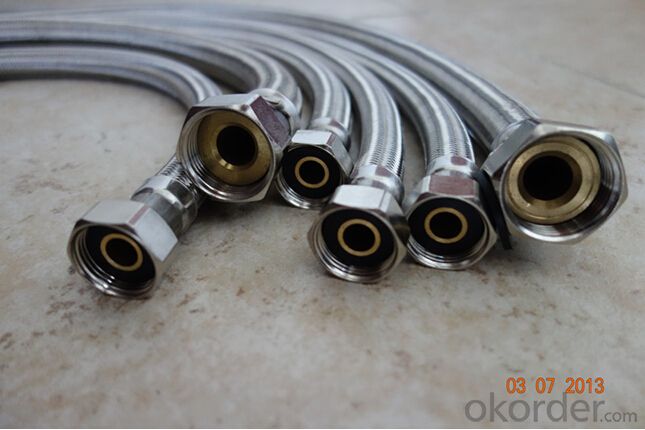
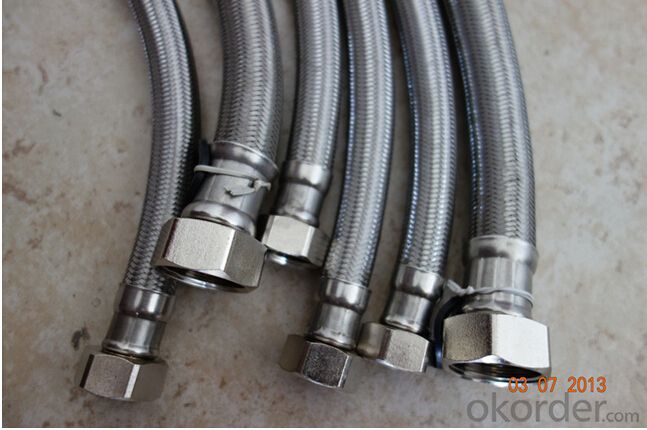
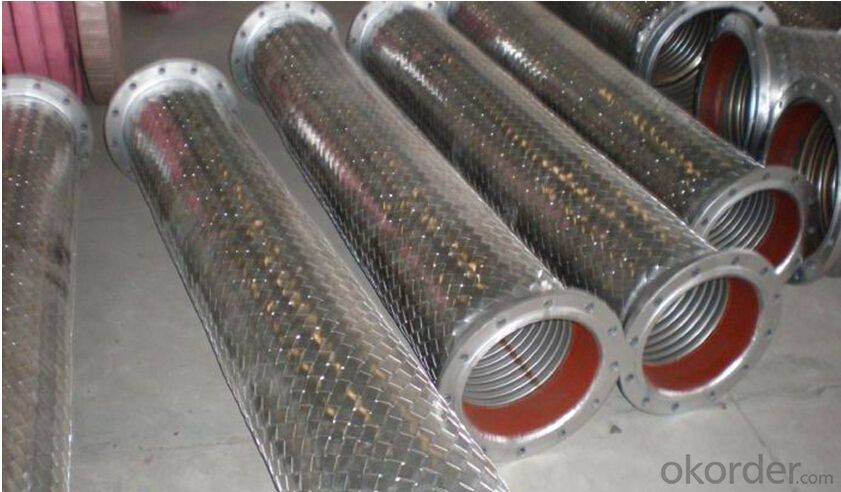
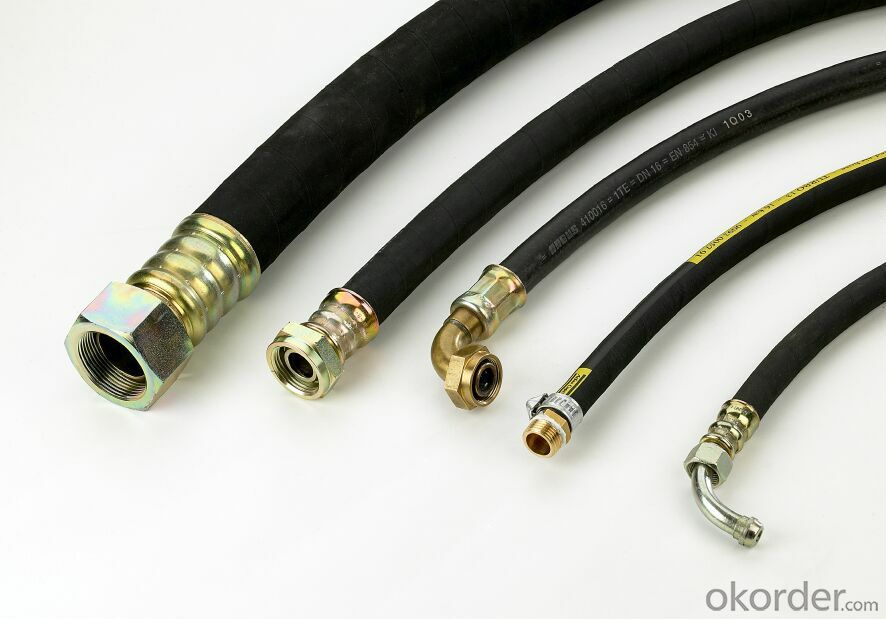
Package of Stainless Steel Braid Hose with Outside Fittings:
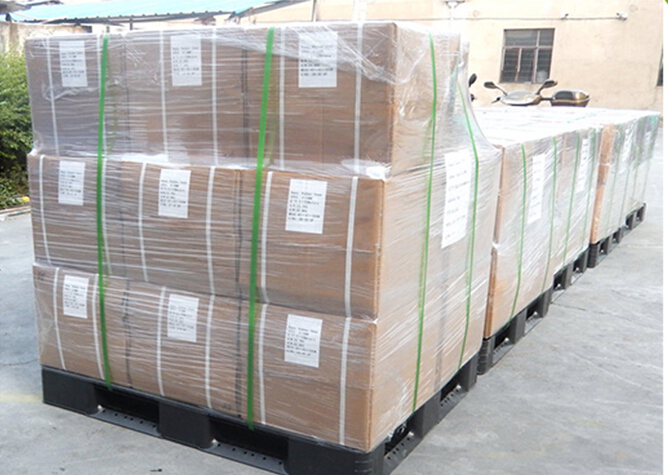
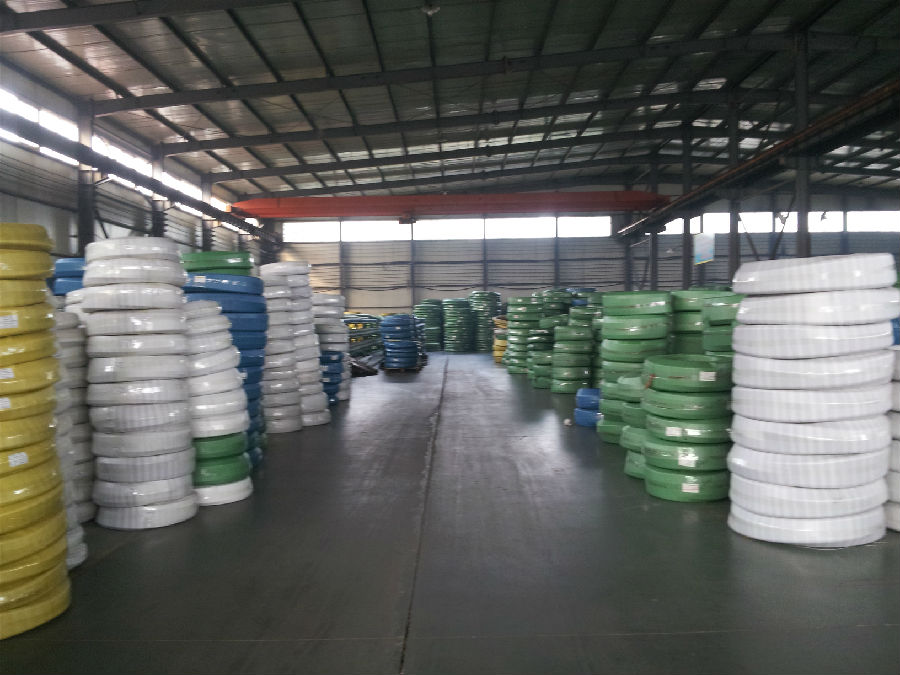
FAQ of Stainless Steel Braid Hose with Outside Fittings:
Who we are:
Answer: We CNBM is a Chinese state-owned enterprise ranked 267th among the Global Fortune 500, as the largest building materials company,we have over 300 affiliated companies,and so many production lines and branch office distribute in China.
2. About our quality:
Answer: Every product needs to be quality proved before shipping.
3. About our service:
Answer: We could gurantte that we can reply you in 2 working hours.
- Q:How do you calculate the bending radius of stainless steel pipes?
- To calculate the bending radius of stainless steel pipes, you need to consider several factors. The bending radius is determined by the diameter of the pipe, the wall thickness, and the type of stainless steel being used. First, you need to determine the outside diameter (OD) of the pipe. This can be measured directly or obtained from the pipe specifications. Next, you should identify the wall thickness of the pipe. This information is available in the pipe specifications or can be measured using a caliper. Once you have the OD and wall thickness, you can calculate the inside diameter (ID) of the pipe by subtracting twice the wall thickness from the OD. This is because the wall thickness is evenly distributed on both sides of the pipe. Now that you have the ID, you can calculate the bending radius. The bending radius is typically expressed as a multiple of the pipe's OD. The general rule is that the bending radius should be at least three times the OD for stainless steel pipes. However, this value may vary depending on the specific application and the type of stainless steel being used. It is important to note that bending stainless steel pipes beyond their recommended bending radius can lead to deformation, cracking, or failure. Therefore, it is crucial to follow the manufacturer's guidelines and consult with an engineer or a professional experienced in working with stainless steel pipes for accurate calculations.
- Q:Can stainless steel pipes be used for solar water heating systems?
- Stainless steel pipes, indeed, have the capability to serve in solar water heating systems. The reason behind this popularity lies in the durability, corrosion resistance, and high-temperature endurance exhibited by stainless steel. Its suitability for enduring the challenging outdoor circumstances and constant exposure to sunlight encountered by solar water heating systems is noteworthy. Moreover, stainless steel pipes are renowned for their long-lasting nature, rendering them a perfect option for prolonged utilization in solar water heating systems. All in all, stainless steel pipes provide exceptional performance and reliability for solar water heating systems.
- Q:How do you calculate the flow rate of stainless steel pipes?
- The flow rate of stainless steel pipes can be calculated using the formula: Q = A × V, where Q represents the flow rate, A is the cross-sectional area of the pipe, and V is the velocity of the fluid flowing through the pipe.
- Q:Can stainless steel pipes be galvanized?
- Yes, stainless steel pipes can be galvanized. Galvanization is a process in which a protective zinc coating is applied to steel or iron to prevent rusting. While stainless steel is already highly resistant to corrosion, galvanizing can provide an additional layer of protection in certain applications. However, it is important to note that galvanizing stainless steel pipes is not as common as galvanizing carbon steel pipes, as the inherent corrosion resistance of stainless steel is often sufficient for most applications. Additionally, galvanizing stainless steel can alter its appearance and may not be suitable for certain aesthetic requirements.
- Q:What is the maximum temperature stainless steel pipes can handle?
- The maximum temperature that stainless steel pipes can handle depends on the specific grade of stainless steel being used. Generally, stainless steel is known for its high temperature resistance and can withstand temperatures ranging from -150°C (-238°F) to 1100°C (2012°F) without losing its structural integrity. However, the exact maximum temperature will vary based on factors such as the grade of stainless steel, the specific application, and the duration of exposure to high temperatures. It is important to consult the manufacturer's specifications and guidelines to determine the maximum temperature limit for a particular stainless steel pipe.
- Q:What kind of welding machine is used for welding thin stainless steel plate and stainless steel square tube?
- 1 argon arc welding machine! If the person who has not been married, as little as possible, that thing has radiation, long time use of physiology is influential. You know what you do.2, regardless of the front and back can be, as long as it looks beautiful and practical.3, welding technology is good, it will not be ugly after welding.4, only the use of technology to make up for the lack of machinery, and then cattle B hardware, there is no good software is not good.5, welding rod, protective mask and so on.
- Q:What is the difference between Sch 40 and Sch 80 stainless steel pipes?
- Sch 40 and Sch 80 stainless steel pipes differ in their wall thicknesses. Sch 40 denotes a pipe with a "Schedule 40" wall thickness, while Sch 80 refers to a pipe with a "Schedule 80" wall thickness. The schedule number signifies the approximate wall thickness of the pipe, with higher numbers indicating thicker walls. When it comes to stainless steel pipes, Sch 80 has a greater wall thickness compared to Sch 40. The variation in wall thickness leads to disparities in pressure rating and strength. Sch 80 stainless steel pipes are engineered to withstand higher pressure and are generally employed in applications where the pipe must endure heightened levels of stress or extreme conditions. Conversely, Sch 40 stainless steel pipes are typically used in less demanding situations where lower pressure ratings are acceptable. Furthermore, the increased wall thickness of Sch 80 pipes results in a smaller internal diameter in contrast to Sch 40 pipes. This reduction in internal diameter can affect the flow rate of fluids or gases through the pipe, so it is crucial to take this factor into account when selecting the appropriate pipe for a specific application. To summarize, the primary distinction between Sch 40 and Sch 80 stainless steel pipes lies in their wall thickness. Sch 80 pipes are thicker and capable of handling higher pressure and stress levels.
- Q:Can stainless steel pipes be embossed?
- Yes, stainless steel pipes can be embossed. Embossing is a process in which a pattern or design is raised or pressed into a material, such as stainless steel, to create a decorative or functional effect. Embossing can be done on various metal surfaces, including stainless steel pipes. The process involves using specialized machinery and tools to imprint the desired design onto the surface of the pipe. This can be done for aesthetic purposes, to add texture or visual interest, or for functional reasons, such as improving grip or preventing slippage. Overall, embossing stainless steel pipes is possible and can be done to achieve various desired outcomes.
- Q:What is the difference between schedule 40 and schedule 80 stainless steel pipes?
- Stainless steel pipes are categorized into schedule 40 and schedule 80 based on their wall thickness. The primary distinction between the two lies in their pressure ratings. Schedule 40 pipes possess a lower pressure rating and are suitable for applications with low to medium levels of pressure. Conversely, schedule 80 pipes have a higher pressure rating and are utilized in high-pressure scenarios. The increased wall thickness of schedule 80 pipes enables them to handle elevated pressure levels, rendering them preferable for situations where the pipe necessitates enduring heightened stress or conveying fluids and gases at higher pressures. These pipes find common usage in industrial environments like oil refineries, chemical plants, and power plants, which are known for their corrosive atmospheres and high-pressure requirements. In contrast, schedule 40 pipes are more commonly employed in residential and commercial settings such as plumbing systems, water supply lines, and HVAC systems, where lower pressure demands are usually encountered. To ensure secure and efficient operation, it is crucial to carefully consider the specific requirements of the project and seek advice from a professional in order to determine the appropriate schedule of stainless steel pipe.
- Q:Are stainless steel pipes suitable for chemical processing?
- Indeed, stainless steel pipes are well-suited for chemical processing purposes. Renowned for their exceptional resistance to corrosion, stainless steel pipes prove to be an optimal choice when it comes to managing a wide range of chemicals in various processing industries. These pipes exhibit resistance not only towards organic and inorganic chemicals, but also acids, alkalis, and solvents. Consequently, they can endure high temperatures and pressures, thus demonstrating their aptitude for handling aggressive chemicals and upholding process integrity. Moreover, stainless steel boasts hygienic attributes, as it is impermeable and effortless to clean, thereby ensuring the purity of the chemicals undergoing processing. Furthermore, stainless steel pipes possess an extended lifespan and necessitate minimal maintenance, thus presenting a cost-effective solution for chemical processing applications.
1. Manufacturer Overview |
|
|---|---|
| Location | |
| Year Established | |
| Annual Output Value | |
| Main Markets | |
| Company Certifications | |
2. Manufacturer Certificates |
|
|---|---|
| a) Certification Name | |
| Range | |
| Reference | |
| Validity Period | |
3. Manufacturer Capability |
|
|---|---|
| a)Trade Capacity | |
| Nearest Port | |
| Export Percentage | |
| No.of Employees in Trade Department | |
| Language Spoken: | |
| b)Factory Information | |
| Factory Size: | |
| No. of Production Lines | |
| Contract Manufacturing | |
| Product Price Range | |
Send your message to us
Stainless Steel Braid Hose with Outside Fittings
- Loading Port:
- Tianjin
- Payment Terms:
- TT OR LC
- Min Order Qty:
- 1000 pc
- Supply Capability:
- 100000 pc/month
OKorder Service Pledge
OKorder Financial Service
Similar products
New products
Hot products
Hot Searches
Related keywords
